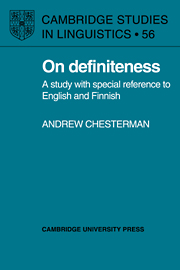Book contents
- Frontmatter
- Contents
- Acknowledgements
- 1 Introduction
- 2 English articles: the research traditions
- 3 English article usage
- 4 A unified description of the English articles
- 5 Finnish: no articles
- 6 Finnish spesies
- 7 The status of definiteness in Finnish
- 8 English and Finnish contrasted
- 9 Wider perspectives
- References
- Author index
- Subject index
4 - A unified description of the English articles
Published online by Cambridge University Press: 18 September 2009
- Frontmatter
- Contents
- Acknowledgements
- 1 Introduction
- 2 English articles: the research traditions
- 3 English article usage
- 4 A unified description of the English articles
- 5 Finnish: no articles
- 6 Finnish spesies
- 7 The status of definiteness in Finnish
- 8 English and Finnish contrasted
- 9 Wider perspectives
- References
- Author index
- Subject index
Summary
Oppositions
At this point it will be useful to step back for a moment and review the major points that have so far emerged. They can be summarized as follows.
(a) Standard descriptions of the articles have too many exceptions, particularly regarding the cases where the is said to be omitted before count singulars, and where a can be used before mass nouns. Proper nouns are also held to be outside the article system proper.
(b) Generic NPs with different articles do not have uniform readings, and the term ‘generic’ itself lacks a unitary definition.
(c) There is good evidence that nouns with ‘no article’ fall into two distinct types: indefinite mass and plural nouns on the one hand, and count singular nouns (and singular proper names) on the other.
(d) It is not a priori clear what the category ‘article’ comprises. In addition to NPs with the, a and some, there is reason to claim that there are also two distinct types of NP which are not preceded by any realized surface article: these we have called the zero and null forms.
(e) ‘Definiteness’ and ‘indefiniteness’ are not simple polar opposites. Indefiniteness is particularly complex, in that the distribution and meaning of a, some and zero are not adequately explained merely in terms of the features [±count] and [±singular]. In particular, zero and some are by no means always in free variation.
[…]
- Type
- Chapter
- Information
- On DefinitenessA Study with Special Reference to English and Finnish, pp. 63 - 89Publisher: Cambridge University PressPrint publication year: 1991



